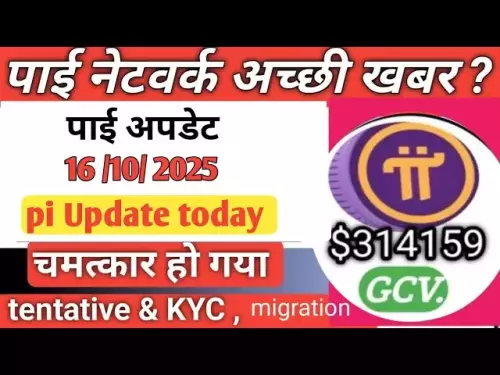 |
|
 |
|
 |
|
 |
|
 |
|
 |
|
 |
|
 |
|
 |
|
 |
|
 |
|
 |
|
 |
|
 |
|
 |
|
Cryptocurrency News Articles
Cracking Crypto Charts: A Beginner's Guide to Reading Charts Like a Pro
Oct 15, 2025 at 09:00 pm
Confused by crypto charts? This beginner's guide breaks down the essential patterns, tools, and techniques you need to interpret price action and trade with confidence.

Crypto charts can seem like a foreign language, but in 2025, learning to decipher them is more crucial than ever. Fresh regulations, new tech, and AI trends are constantly influencing the market, making chart-reading a must-have skill.
Crypto Chart Fundamentals
Crypto price charts visually represent price movements across different timeframes, offering insights into trends, volatility, and trading opportunities. In the fast-paced crypto market, open-high-low-close (OHLC) data enables investors to track price changes within specific periods, forming the core of technical analysis.
Key Components
Understanding the structure of crypto charts is essential for traders. Key components include:
- X-axis: Multi-timeframe analysis is key to balancing short-term trades with a long-term outlook. You can adjust charts from one-minute to monthly intervals.
- Y-axis: The price scale can be set to linear or logarithmic. A logarithmic scale is more useful for long-term crypto analysis because it highlights percentage-based changes more clearly.
- Volume bars: These show market activity and help confirm chart patterns by indicating whether a breakout or reversal is backed by strong trading participation.
Foundational Chart Types
Some chart types form the foundation of technical analysis. The most common ones include:
- Candlestick: The most widely used chart type, showing OHLC data within a single bar.
- Line: Offers a quick view of overall trends by connecting closing prices over time.
- Bar: An alternative to candlesticks that also displays the OHLC structure in a simpler format.
With the rise of AI, charts that integrate onchain data, such as wallet activity and total value locked (TVL), are becoming increasingly popular. These advanced charts give traders deeper insights into evolving market dynamics.
Did you know? Candlestick charts originated in 18th-century Japan, where they were first used to track rice trading, long before making their way into modern crypto markets.
Five Most Popular Chart Patterns in Crypto Trading
Chart patterns are shapes formed by price movements that help traders anticipate future market trends. These patterns fall into two main categories: reversal patterns, which signal that a current trend may change direction, and continuation patterns, which suggest the trend will likely resume after a brief pause. They stem from market psychology, where emotions like fear, greed, and uncertainty drive collective trading behavior and create recognizable shapes on charts.
Here are five common patterns every crypto investor, including beginners, should know:
1. Head and Shoulders
The head-and-shoulders pattern features three peaks, with a higher middle peak (the head) between two smaller ones (the shoulders), all connected by a “neckline.” The inverse version indicates a potential bullish reversal.
How to read: A decline in volume on the right shoulder signals weakening momentum. A price break below the neckline confirms a bearish reversal, while a break above it confirms a bullish inverse. Measure the distance from the head to the neckline, then project that distance from the breakout point to estimate the target move.
Stop-loss: Place it above the right shoulder for bearish setups or below it for bullish ones.
Example: In early 2025, Cardano (ADA) formed a head-and-shoulders pattern during a correction phase after its governance upgrade buzz, signaling a temporary bearish move.
2. Double Top and Double Bottom
Double tops form an “M” shape near resistance, signaling a potential bearish reversal. Double bottoms form a “W” shape near support, signaling a potential bullish reversal.
How to read: These patterns show two failed attempts to break resistance (top) or support (bottom). Confirmation occurs when the price crosses the neckline: bearish for double tops and bullish for double bottoms. Measure the height from the neckline to the peaks or troughs, then project it from the breakout point to estimate the move.
Stop-loss: Place it above the top peaks or below the bottom troughs.
Example: Dogecoin (DOGE) formed a double top in mid-2025 after a social media-driven surge, followed by a sharp correction.
3. Triangle
Triangle patterns form when price movements create converging trendlines, resulting in a triangular shape. The three main types are ascending (bullish), descending (bearish) and symmetrical (neutral).
How to read: Breakouts often follow the existing trend but can occasionally reverse it. Estimate the price target by measuring the base width of the triangle and projecting it from the breakout point. A breakout upward in an uptrend is typically bullish, while a breakdown in a downtrend is bearish. To avoid false signals, use a 1%-2% filter before confirming a move.
Stop-loss: Place it below the triangle for bullish setups or above it for bearish ones.
Example: In early 2025, Ether’s (ETH) price action formed a symmetrical triangle amid uncertainty surrounding decentralized finance (DeFi) regulations. The price later broke out bullishly as regulatory clarity improved.
4. Flag and Pennant
Flag and pennant patterns form after sharp price moves. Flags appear as small, parallel channels, while pennants look like compact triangles. Both signal brief pauses before the prevailing trend continues.
How to read: A steep “pole” followed by a short consolidation suggests that the trend is likely to resume. These patterns are bullish in uptrends and bearish in downtrends. Traders often enter on a pullback within the flag or pennant to improve risk-reward.
Stop-loss: Place it below the flag or pennant’s low for bullish setups, or above the high for bearish ones.
Example: In 2025, Solana’s (SOL) price action formed a bullish flag pattern amid rapid ecosystem growth, including new DeFi protocol launches. This setup signaled the continuation of its upward trend.
5. Wedge
Wedge patterns form when price action creates converging trendlines that slope either upward (rising wedge, typically bearish) or downward (falling wedge, typically bullish).
How to read: A rising wedge in an uptrend often signals a potential reversal as momentum weakens, while a falling wedge in a downtrend points to a possible bullish reversal. These patterns can also act as continuation signals when aligned with the prevailing trend. Measure the wedge’s height and project it from the breakout point to estimate the target move.
Stop-loss: Place it outside the wedge’s opposite trendline.
Example: In 2025, during a period of heightened speculation, Arbitrum’s (ARB) price action formed a rising wedge pattern, which was later followed by a market correction.
Did you know? Many crypto traders prefer logarithmic charts over linear ones. While linear scales display absolute price changes, log scales highlight percentage changes, making it easier to compare Bitcoin’s early rise from $1 to $10 with its later move from $10,000 to $20,000, both representing 10x growth.
Complementary Tools and Indicators for Trend Analysis
To strengthen your trend analysis, you can use several key indicators and tools. Important indicators include:
- Moving averages (SMA/EMA crossovers): Track trends by watching when a short-term exponential moving average (EMA) crosses above or below a long-term simple moving average (SMA).
- Relative Strength Index (RSI): Detects overbought (>70) or oversold (prevents traders from chasing rallies or exiting too early during corrections.
- Moving average convergence/divergence (MACD): Uses a histogram to identify momentum shifts when the MACD line crosses the signal line.
- Bollinger Bands: Track volatility squeezes to spot potential breakouts or reversals.
- Volume analysis: Volume spikes confirm market participation during breakouts or reversals, validating chart patterns.
Did you know? Volume bars are more than background visuals. They confirm whether price breakouts are trustworthy. A surge in volume during a breakout signals strong market participation, while low volume may warn of a false move. Many traders view volume as the “heartbeat” of chart analysis.
Risk Management and Best Practices
Successful crypto trading relies on strong risk management and disciplined methods. Avoid analyzing patterns in isolation: Instead, combine chart patterns with indicators (such as RSI) and relevant news to improve accuracy. Always risk only a small portion of your capital to protect against sudden market volatility.
From a psychological standpoint, resisting fear of missing out (FOMO) is essential in 2025’s AI-driven environment, where automated trading and social media can easily inflate asset prices. Stay grounded, avoid hype and remain committed to your strategy.
Common mistakes include falling for false breakouts without volume confirmation and overtrading on short timeframes, which can lead to mental fatigue. To strengthen your approach, consider backtesting: applying your trading strategy to historical data to evaluate its past performance and potential future profitability.
So, there you have it! Crypto charts might seem daunting at first, but with a little practice, you'll be spotting those head and shoulders patterns like a Wall Street whiz. Now go forth and conquer those charts – just remember to set those stop-losses!
Disclaimer:info@kdj.com
The information provided is not trading advice. kdj.com does not assume any responsibility for any investments made based on the information provided in this article. Cryptocurrencies are highly volatile and it is highly recommended that you invest with caution after thorough research!
If you believe that the content used on this website infringes your copyright, please contact us immediately (info@kdj.com) and we will delete it promptly.
























![Web3 Crypto Market Morning Report: The market is in decline, altcoins have fallen by more than 5%, Binance compensation has been received, and Memes on the Bnb chain have collectively plummeted [Vic TALK Issue 1444] Web3 Crypto Market Morning Report: The market is in decline, altcoins have fallen by more than 5%, Binance compensation has been received, and Memes on the Bnb chain have collectively plummeted [Vic TALK Issue 1444]](/uploads/2025/10/16/cryptocurrencies-news/videos/web-crypto-market-morning-report-market-decline-altcoins-fallen-binance-compensation-received-memes-bnb-chain-collectively-plummeted-vic-talk-issue/68f043c9c8b44_image_500_375.webp)





































